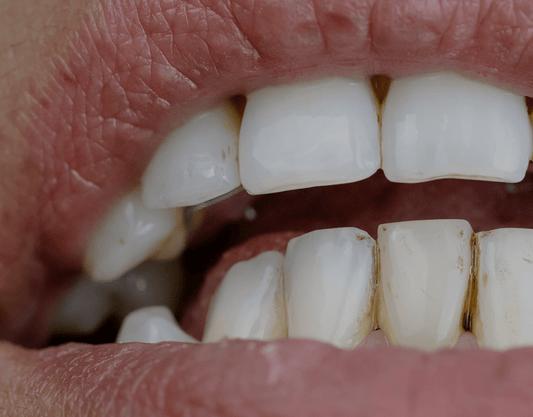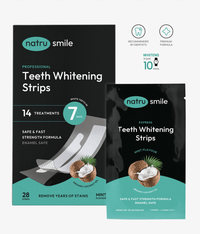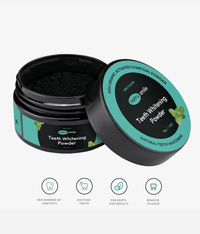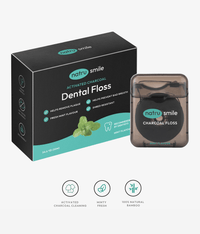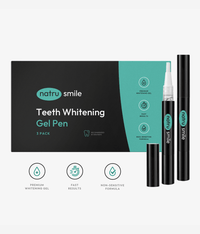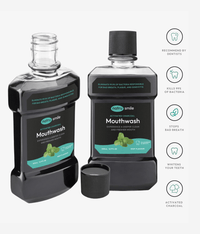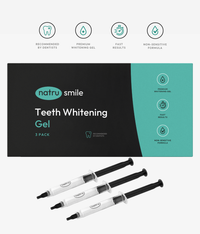
All products are certified by dental expert Dr. Greg Grillo
When you get brown stains on your teeth, your first response might be to freak out. After all, yellow teeth are somewhat more explainable, but it's harder to justify brown teeth. However, brown teeth are more common than you think, and we know what causes them.
We also know many ways to remove brown stains from your teeth and prevent them from returning. But a good first step to bringing your teeth back to their original white shade is understanding your options.
In this article, you'll learn more about the potential causes, treatments, and preventatives of brown teeth.
Why You Have Brown Spots On Your Teeth: Common Causes
There are many common causes of brown teeth. Much like your body's signals, it's a sign to take action and possibly consult a medical professional.
Below, you'll find some more common causes of brown spots on your teeth.
Food & Beverages
Surface stains are often caused by whatever you are eating or drinking at the time. So, when your teeth turn brown, think about what you've consumed during the day.
Sometimes, the food or drinks you consume can dye your teeth. Coffee, for example, is one of the biggest culprits of teeth staining.
Alternatively, the compounds within your food can also affect your teeth. Tannins, for example, is a plant-based compound found in tea that sticks to your teeth.
Here's a list of other consumables that can impact your teeth:
- Red wine
- Soda
- Popsicles
- Fruit juice
- Soy sauce
- Balsamic vinegar
- Sports drinks
- Colored candy
- Berries (blueberries, blackberries, etc.)
- Pomegranates
- Curry
- Tomato-based sauces
- Slushies
Severe Fluorosis
Fluorosis is a discoloring of the teeth that happens as a result of too much fluoride. For the teeth to become brown, it would have to be an extreme form of fluorosis.
Fluorosis happens in children ages eight or younger. Anyone older than this cannot get fluorosis.
In most cases, fluorosis causes a few white spots on the teeth. However, extreme coloration can occur depending on the fluoride taken.
An overabundance of fluoride in your drinking water is one potential cause of it.
Tobacco Products
Tobacco products are a well-known cause of stains. Your teeth have tiny pores that soak up the nicotine and tar from smoking, leading to potential discoloration.
Chewing tobacco, cigars, and cigarettes are the most notable causes of these stains. However, vaping and electronic cigarettes might also stain your teeth.
Medications
Some medications that you take can lead to discolored teeth. These discolorations are often from the side effects of medicines you take. The most common side effect leading to brown teeth is dry mouth or limited saliva production.
Below is a list of different types of medication related to why they might cause brown teeth:
- Antibiotics - The three antibiotics that might cause brown teeth are Tetracycline, Minocycline, and Doxycycline (not an exhaustive list). In many cases, the staining caused by these three was reversible.
- Antihistamines - Teeth browning comes as a result of antihistamines preventing saliva production. The body relies on saliva to break down substances. Some of those substances cause brown staining.
- Antihypertension - Medications to treat hypertension can sometimes cause dry mouth. Like antihistamines, the lack of saliva in your mouth can cause brown teeth from the build-up of substances.
Age
The hard white enamel on the outside of our teeth is strong when we are young.
Naturally, when we get older, we use our teeth. So, the more those teeth are used, the more the enamel breaks down.
Age is just as likely to cause yellow teeth, so it’s best not to assume age is what’s causing your discoloration. Consult a dentist to get their opinion on your teeth.
Enamel Hypoplasia
Enamel Hypoplasia is an enamel defect that occurs as the teeth develop. This defect can lead to thin enamel, causing it to be more susceptible to tooth decay, which leads to brown spots.
It can affect people of all ages and often comes with unusual gaps, chips, or small teeth. It can come from trauma, infection, jaundice, or a few other conditions.
It's also caused by a similar genetic condition, Amelogenesis Imperfecta. Both conditions can be impacted by your genetic history.
Celiac Disease
Celiac Disease can affect many different body parts. While you might know it for its gastrointestinal effect, dentists can identify people with Celiac Disease based on their teeth.
Celiac Disease leads to the enamel defect covered above: Enamel Hypoplasia.
However, because this defect comes from many sources, it's not safe to assume that a person’s thin enamel comes from Celiac Disease. Consult a medical professional to get confirmation on your condition.
Vitamins And Supplements
Vitamins and supplements can cause tooth discoloration in two ways:
First, supplements often contain citric acid and (sometimes) use sugar. This is more common in children's gummies, leading to long-term tooth issues and enamel weakening.
The second way is more of a lack of vitamins. Specifically, the discoloration can be caused by a vitamin D deficiency. You'll often see vitamin D issues connected with discolored teeth or enamel defects.
Trauma
Trauma can lead to discoloration in the same way an injury leads to bruising. Your tooth's darker (sometimes brownish) color might signal an injury.
In most cases, trauma causes a grey tooth, but coloration can come in many forms. Consult a professional if you've recently experienced trauma or have undergone dental surgery and are experiencing unusual discolorations.
Tooth Tartar
Tooth tartar is an extreme build-up and hardening of dental plaque, which comes from the gunk in your teeth. This substance can discolor heavily depending on what you consume and the bacteria in your mouth.
Tartar, also known as calculus, builds on the gum line and comes from poor oral health. To prevent this build-up, you can brush, floss, and use mouthwash regularly.
Tooth Decay
Tooth decay connects to many other potential causes on this list. For example, you might have a disease that weakens enamel, making it easier for cavities to decay your mouth.
Cavities can grow to cover a wide area, especially when ignored. Without proper care, these cavities can become a huge issue.
Signs of cavities might include small, black stains on teeth. If the black stains grow, it might signify other complications.
Genetics
Genetics can sometimes lead to specific defects or conditions. For example, Dentinogenesis Imperfect is one condition that could come from your genes, leading to discolored teeth (either translucent or yellow-brown).
The gene impacted is the DSPP gene, which provides instructions for making various components of the teeth. When these components aren't made correctly, it can lead to complications.
By comparison, consider a construction crew with an incorrect copy of blueprints to build a house. Without the proper blueprints, the house won't be built up to the expectations of those who want it built. Genes with these conditions might build teeth with weaker components.
How To Get Rid Of Brown Stains On Teeth Naturally At Home
Now that you know what causes brown teeth, you can take action on what to do next. The first set of options you might consider is at-home teeth whitening solutions.
At-home solutions are appealing because they are inexpensive and can be done on your time. Below are some steps you can take to potentially get rid of surface stains at home.
Mouthwashes
Mouthwash is generally used to remove bacteria from your mouth. However, mouthwash also works as a way to make brighter teeth.
Teeth whitening mouthwash is a great tool to get results that can come in a few weeks. They manage this by including a peroxide-based additive known for encouraging white teeth.
Toothpaste
Another solution you can purchase is teeth-whitening toothpaste. These kinds of toothpaste can effectively remove surface stains from your teeth.
Whitening toothpaste contains a mildly abrasive substance (similar to baking soda) to remove stains. With the proper brushing techniques and (optional) an electric toothbrush, you might be able to remove those stains easily.
Whitening Strips
Whitening strips follow the same logic as mouthwash: using a substance that helps your teeth whiten. The substances used are either bleach or peroxide.
Whitening strips are known to be most effective for stains caused by smoking, coffee, aging, or genetics. So, this bleaching process is less effective for yellow teeth.
Other At-Home Teeth Whitening Kits
Other at-home teeth whitening kits might include trays or LED-based whiteners. Stick to dentist-approved products to ensure their effectiveness.
Trays tend to have more of a proven background in whitening, while LEDs have more skepticism behind them. So choose what you think will work best for you and ideally backed by science.
Baking Soda & Water
Another of the more trusted teeth whitening options are baking soda and water.
Because baking soda is mildly abrasive, it's known for having effective whitening properties and is often trusted by dentists.
When combining baking soda with water, you can coat your toothbrush with it. Including this as a part of your regular oral care routine can help whiten your teeth.
Professional Solutions To Remove Brown Teeth Stains
When natural teeth whitening is ineffective, professional solutions can help save the day. Despite the higher price tag behind these, professional whitening treatment can help you reap the benefits of white teeth faster.
Professional solutions also might be the only option for those with more serious conditions. For example, if your brown teeth are related to a medical issue, a trained professional can make that determination with their experience and knowledge.
Professional Cleaning
Professional cleanings are often recommended every six months (or twice a year). They have two benefits:
- First, you get the benefit of having a deep clean twice a year. These deep cleans can be great for improving your dental hygiene.
- Second, your dentist can spot issues you don't. Years of medical training lead to them being able to spot problems (like brown teeth) before they become big.
Professional Teeth Whitening
A professional teeth whitening process is similar to using whitening trays from home. The difference here is that professional whitening's can go deeper.
Unlike trays, which are more effective for surface stains, professionals rely on a stronger chemical concentration. This means that they are more effective than at-home alternatives.
The one drawback to professional whitening's is the cost. So be sure to save up and compare your options before buying from a professional.
Dental Bonding
Dental bonding is a procedure that fills in the gaps or chips on a tooth with resin. This resin matches the tooth's color, meaning it can also be used to cover discoloration.
The resin in dental bonding is the same material dentists use to fill cavities. This makes it incredibly effective for those who have defects alongside their brown teeth.
While this is technically not a removal, it does make your teeth appear to have the brown spots removed. Our next suggestion also follows the same logic.
Veneers
Dental veneers are cosmetic coverings that fit over the front of your teeth. The veneers are often made of porcelain, making them a visual replacement for your teeth.
Veneers are great for making your teeth look more visually impressive. However, unlike other procedures (like crowns), these do not help restore teeth' functionality.
Veneers typically cost more than dental bonding but consult your cosmetic dentist for details.
How To Prevent Brown Teeth Stains
If you've managed to remove the brown stains from your teeth, you probably won't want them back any time. To prevent these teeth stains from ever returning, check out this list of tips for prevention:
Brush Your Teeth with Toothpaste Containing Fluoride
One of the more common causes of teeth stains is lingering food or beverages. One of the most effective ways to improve your smile is to remove those lingering foods or drinks with toothpaste, specifically, the kind that has fluoride.
Fluoride is a naturally occurring mineral proven to help build strong teeth. It's ADA-approved for tooth care and is recognized as effective and safe.
When you brush your teeth, it removes all the gunk from the data. This gunk leads to plaque and cavities, eventually leading to tooth decay.
Floss At Least Once A Day
Another part of the tooth care routine that's easy to forget is flossing. If you want your healthiest smile, flossing can help get the gunk that's harder to reach for your toothbrush.
It's recommended you floss at least once a day. The best time is during the night and after you eat dinner. This lets you remove all of the unwanted food gunk from your teeth (so you don't end up sleeping with it all night).
Use A Fluoride-Containing Mouthwash
Fluoride is a common mineral found in all dental care products. So, it makes sense that you should also pursue a mouthwash that contains the mineral.
There are several fluoride types of mouthwash, many of which also have tooth-whitening properties. Taking the approach to target two problems with one solution might help you save time.
Have A Regular Dental Check-Up
As we've said earlier in this article, a regular dental check-up has two benefits.
These benefits include cleaning teeth and spotting problems.
Dental check-ups should ideally occur twice a year. The only time you ever need more check-ups is if you have some condition.
But you won't know if you have the condition until you go to the dentist's office. So, if you haven't in a while, today is the day to call your dentist.
Stop Smoking
In the US, 13 of every 100 adults use tobacco products. These adults suffer from a wide range of preventable diseases that would stop if only they didn't smoke.
If you are reading this and you smoke, this is your wake-up call.
When you stop smoking, all those problems (including the ones that caused brown teeth) can disappear. So protect that beautiful smile (and that beautiful you), and stop smoking today.
Wrap Up
From what you've read above, you know that many different things cause brown stains on teeth. Those things can be broken down into what you consume, your genetics, and your medical conditions. Regardless of why you have them, you can take steps to remove them.
The best place to start is with at-home remedies. Using baking soda and finding at-home whitening products is a great way to remove these stains.
If those first steps don't work, you can move on and pursue professional whitening. Professionals are expensive but tend to get results faster.
Of course, if you want to prevent these brown stains, keep your oral hygiene in mind and stay in contact with regular cleanings. Even if your brown teeth come from genetics, oral hygiene can help you create a happier mouth.
Do Brown Spots On Teeth Go Away?
Brown spots caused by surface tooth stains are removable using over-the-counter whitening solutions. However, deeper discolorations caused by tooth decay might not go away. These deeper colorations often require professional work from a dentist.
Can Brown Teeth Be White Again?
In many cases, brown teeth can be white again with little work. With surface stains, you can turn them back using whitening solutions like strips. With persistent problems, you'll want to seek in-office teeth whitening from a dental professional.
Are Brown Teeth Permanent?
In most cases, having brown teeth isn't a permanent problem. You can reverse browning teeth through professional cleanings, regular toothbrushing, and using whitening products. Also, avoiding foods and activities that make your teeth brown will help encourage a whiter mouth.
What Causes Brown Teeth In Adults?
Adults frequently get brown teeth because of what they consume. Adult beverages like coffee, soda, and wine can cause tooth stains. Using tobacco products (chewing or smoking) is also a common cause of brown teeth in adults.
Alternative reasons relate to poor dental hygiene, a calcium deficiency, or aging.
Why Do Front Teeth Turn Brown?
Your front teeth are more likely to turn brown because they see more use than the rest of them. As a result of this use, tooth decay is a fairly common problem for those with brown teeth. Because you often use your front teeth to bite down on food, it might also be caused by eating foods that tend to stain your teeth (like berries or things covered in soy sauce).
Can Badly Stained Teeth Be Whitened?
In many cases, even severely stained teeth can become white again. The best whitening solution for badly stained teeth is to get help from a dental professional. However, mixing baking soda and water is an effective at-home alternative for people who can't afford to see a dentist. Baking soda's abrasiveness makes it one of the more effective at-home remedies.
How Long Does It Take For Brown Teeth To Turn White?
Once you start healthy teeth cleaning habits, it typically takes two or more weeks to see brown teeth become white again. However, the length of time it takes for whitening depends on the severity of the staining. It might take much longer if the staining is related to more serious medical conditions.
Are Brown Teeth Healthy?
Brown teeth are not typically healthy. While darkening teeth is natural as you age, your teeth should rarely darken to brown. Brown teeth are often a sign of decay or poor oral hygiene. While slightly yellow teeth can sometimes still mean healthy, brown teeth seldom connect with a healthy mouth.
Is Brown Tooth Decay Reversible?
Tooth decay is reversible, but only if you catch it early. This is why checking in with your dentist every six months is incredibly important. When the "brown" of decayed teeth reaches deeper, you might lose the tooth entirely, leading tooth decay to eventually become irreversible.
What Disease Makes Your Teeth Brown?
One cause of brown teeth related to medical conditions is Dentinogenesis Imperfecta, which colors your teeth grey, yellow, or brown. Additional signs of this disease include tooth breakage. Alternatively, Celiac disease has been known to cause brown teeth.
Do Teeth Go Brown With Age?
The white outer surface of our teeth tends to leave with age, eventually wearing to a yellow underside. Brown is less common, so those getting brown teeth as they age should have more concern. With guidance from a dentist, you'll find out whether your teeth are naturally turning brown or related to another issue.

